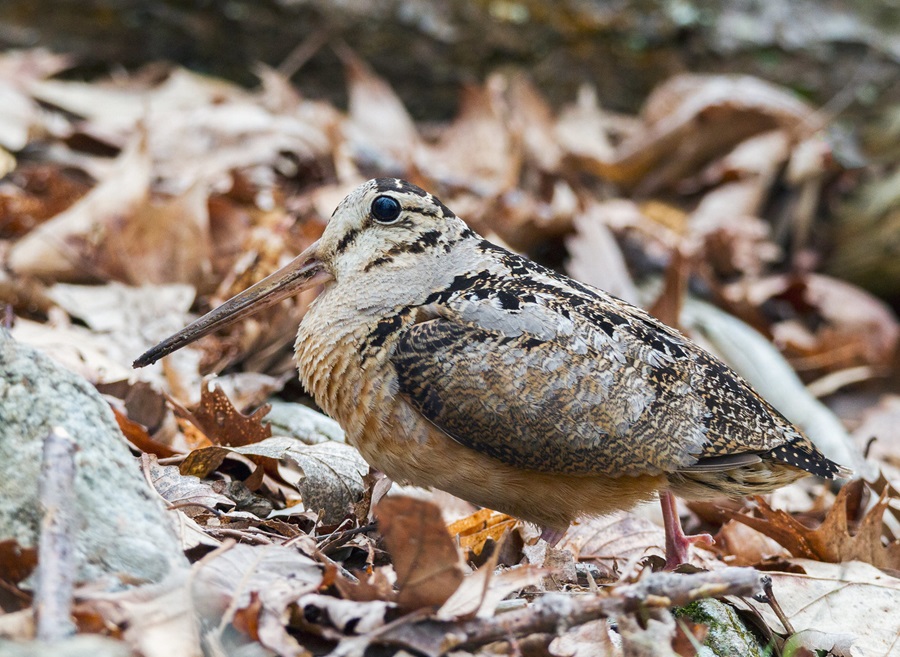It was a still March evening, and I was watching the sunset along the Pilgrim Spring bike path in Truro. For what seemed like a long while, the marsh there was filled with singing birds using the last of the daylight to proclaim their territories and attract mates. Then, apart from the distant chirping of red-winged blackbirds and common grackles congregating at their roosts, all the birds had gone silent, when, right around sunset, a loud, nasal peent sliced through the quiet. Somewhere in the distance, an American woodcock was waking up for the night.
These birds are found in shrubby and open areas all over the Cape, but they can be hard to see: the woodcock’s sandy-brown plumage looks so much like leaf litter that it blends in almost completely with the forest floor. I’ve encountered them at High Head and at the Highland Museum in Truro, around the Herring River in Wellfleet, and at Fort Hill in Eastham.
People have given woodcocks some unusual nicknames: the timberdoodle, Labrador twister, bogsucker, and hokumpoke, to name a few. The odd names are fitting for such a goofy bird. Woodcocks are shorebirds that have completely abandoned the shore in favor of wet uplands, and this strange evolutionary path has given them wacky proportions. Its body is squat, like a chicken’s, held off the ground by short legs, and attached, with seemingly no neck, to its head. That head is odd, too. Like many shorebirds, woodcocks have long, sensitive, and flexible bills whose tips can open independently and which they use to probe for earthworms and other bugs in the mud. Its big eyes, designed for night vision, are set so high on its head that it has a 360-degree field of vision.

In addition to its unusual build, the woodcock is known for its bobbing behavior or dance. As they walk, they rhythmically rock their plump bodies back and forth. The moves are adorable, though scientists disagree as to why they move that way.
But to appreciate what really makes woodcocks famous, you need to see them display. I headed back to my car and drove up the nearby bluff to Cliff Road. On my left, the trees thinned out and the vegetation became shorter and sparser — these are perfect display grounds for woodcocks. Hopping out of the car, I could hear four or five of them peent-ing, so I bushwhacked my way into the scrub.
There it was: another noise — a twittering from the sky. I spotted a plump shape rising above my head. If woodcocks look round on the ground, they are especially spherical in flight. I watched as this round bird slowly worked its way upward on rapid, frantic wingbeats before reaching some desired altitude and flying in tight ovals, twittering all the while. This sound is generated by air passing over its thin outer wing feathers as it flaps.
Soon, the woodcock began dropping, zig-zagging its way to the ground while singing a soft, warbled song until it disappeared behind a shrub. Before long, I heard another peent coming from that direction — it wouldn’t be long until this same male woodcock rose into the sky again to display. Around me, other woodcocks were doing the same thing.
Like so many awe-inspiring things in the bird world, this “sky dance,” as nature writer and environmentalist Aldo Leopold called it in his 1948 Sand County Almanac, is done to attract a mate. Only male woodcocks display, while the females watch them. Once a female has chosen a favorite, she flies over and lands next to her pick, who then approaches the female in a way that seems in keeping with its odd style: holding its wings over its head while walking stiff-legged and making occasional bobs and bows. After they mate, the male flies off and continues displaying — he plays no role in raising offspring.
I’ve never seen this part of the woodcock’s display, which happens in near darkness. Woodcocks do it only at dawn or dusk, though they’ll sometimes go later into the night if the moon is bright. These rituals begin in mid-March, around when they presumably return to the Cape, and will continue well into spring.
Between their funky appearance, their noises, and their displays, woodcocks have established themselves within the folk tradition of North America. Yet they were once also popular game birds, with around two million harvested annually each year in the 1970s.
In recent years, though, that number has dropped to around 350,000, according to Cornell’s Birds of the World. In place of hunting, “woodcock walks” have become popular trips for local birding clubs. With their dramatic displays being easy to watch, even without binoculars, seeing these birds is usually just a matter of getting out to the right habitat. We’re lucky on Cape Cod that we don’t have to go too far to see them.



